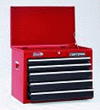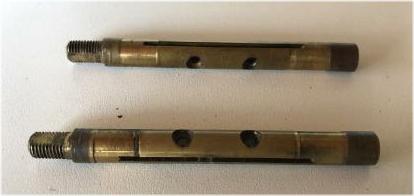

TechTip #7
‘Air leaks in the Carburettors’
 Air leaks between the carburettors and between them and the cylinder head can be hard to diagnose and difficult to track down. Almost any connection is a potential problem and the permutations in subsequent behaviours are large. That makes diagnosis difficult. Air leaks between the carburettors and between them and the cylinder head can be hard to diagnose and difficult to track down. Almost any connection is a potential problem and the permutations in subsequent behaviours are large. That makes diagnosis difficult.
| |

Throttle shafts
|
 If we start with the carburettor itself then worn throttle shafts, can lead to erratic running as the amount of the air leak can vary depending on the position of the throttle shaft and temperature (= amount of expansion). All that leads to the mixture strength varying and so strange running behaviours and making the car impossible to tune. This problem is fixable but the carbs need to come off the engine and be rebuilt. Club members have the technology. Check by seeing if the throttle shafts have play in them, up/down and in/out (not side to side as there will be a very little play here and the shafts have to be able to rotate, of course). You shouldn’t feel any play. If you do its time to open things up and investigate further. If we start with the carburettor itself then worn throttle shafts, can lead to erratic running as the amount of the air leak can vary depending on the position of the throttle shaft and temperature (= amount of expansion). All that leads to the mixture strength varying and so strange running behaviours and making the car impossible to tune. This problem is fixable but the carbs need to come off the engine and be rebuilt. Club members have the technology. Check by seeing if the throttle shafts have play in them, up/down and in/out (not side to side as there will be a very little play here and the shafts have to be able to rotate, of course). You shouldn’t feel any play. If you do its time to open things up and investigate further.
 There are other things to look for as well. There are a lot of rubber hoses and connections in the system. Depending on the car look at, vacuum advance pipes (do check both ends!!), Brake Servo hose (again both ends!, EGR valves, anti-run on valves and so on. Cracks, breaks, even just old hard rubber that’s no longer ‘grippy’ can let in air. There should be no open ends allowing air into the system after the carburettor air inlets, aka air filters. Some cars have bolts going into the inlet manifold. Make sure they are tight, sealed and in most cases there will be a copper washer between the bolt head and the manifold to ensure sealing, hopefully. As time went on the later cars got more and more emissions equipment which generally led to more and more connections, that after 40+ years, can now be giving source to problems. So check. There are other things to look for as well. There are a lot of rubber hoses and connections in the system. Depending on the car look at, vacuum advance pipes (do check both ends!!), Brake Servo hose (again both ends!, EGR valves, anti-run on valves and so on. Cracks, breaks, even just old hard rubber that’s no longer ‘grippy’ can let in air. There should be no open ends allowing air into the system after the carburettor air inlets, aka air filters. Some cars have bolts going into the inlet manifold. Make sure they are tight, sealed and in most cases there will be a copper washer between the bolt head and the manifold to ensure sealing, hopefully. As time went on the later cars got more and more emissions equipment which generally led to more and more connections, that after 40+ years, can now be giving source to problems. So check.
 The inlet manifold can leak at the gasket to the head. We once found three stripped studs out of four on a members MGB. The car ran fine from cold for a bit until it warmed completely up, then things would expand, the gaps would increase allowing more air to be sucked in, mixture went lean(er) and the car essentially wouldn’t run. To diagnose such leaks the easy way is to take something not mega flammable, e.g. WD40 rather than carb cleaner(!) and spray it around all the joints. If they are leaking air the engine note will change as the spray gets sucked in and you can investigate further. If the engine note doesn’t change then what you are spraying is not getting into the air/fuel stream and all is well. The inlet manifold can leak at the gasket to the head. We once found three stripped studs out of four on a members MGB. The car ran fine from cold for a bit until it warmed completely up, then things would expand, the gaps would increase allowing more air to be sucked in, mixture went lean(er) and the car essentially wouldn’t run. To diagnose such leaks the easy way is to take something not mega flammable, e.g. WD40 rather than carb cleaner(!) and spray it around all the joints. If they are leaking air the engine note will change as the spray gets sucked in and you can investigate further. If the engine note doesn’t change then what you are spraying is not getting into the air/fuel stream and all is well.
Happy hunting!
Steve Skegg
Technical Coordinator
Editor Note: Steve is a long-time active member of the Chicagoland MG Club and spends his days working on British cars in the Fix-it Garage in Naperville, IL. These Tech Tips are his personal favorites of things that go wrong with the cars he sees. This will be a continuing article in the coming issues of Driveline.
|